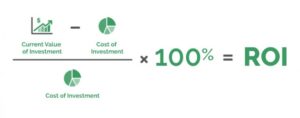At first glance, the question ‘what is a good return on investment (ROI)?’ seems like a no-brainer. I mean, let’s be honest, it is a silly question, isn’t it? The answer is so obvious. But then it hits you and you really start to think about it.
No, seriously. What exactly is a good ROI?
The utopian in you knows that any investment that leads to investors making a profit is a good investment. Not losing money is good. Losing money is bad. But that also challenges the skeptic in you.
Is that really true? How little is too little? How much is too much? What about Uber?
According to a CBC news report, the ride-hailing company loses about 58 cents each time someone orders a cab. Yet, surprisingly, it keeps attracting investors to invest in the company, which since its inception in 2009 hasn’t once turned a profit.
What is ROI?
In the traditional sense of the term, a return on investment means exactly what it sounds like. It’s a return that investors expect on the investments they make. For years, the metric has been used to analyze how profitable an investment is.
Most businesses around the globe use ROI as an integral metric to analyze the efficiency of an investment over time and decipher whether the strategy behind the decision was productive. Using these findings, businesses can make a decision on whether to follow the same investment strategy in the future and/or compare different options to determine the best one.
In terms of putting a numerical value on it, ROI can be calculated by taking the difference between the current value of the investment and the cost of the investment, and dividing that value by the cost of the investment. Needless to say, the higher the number, the better the ROI.

But, is the expected return from an investment supposed to be monetary?
That’s where it gets tricky. Gary Vaynerchuk, the CEO of VaynerMedia and chairman of VaynerX — a media and communications company — might have the answer to that question. He says:
ROI isn’t about the tool, it’s about investing the time and effort to use it correctly. The 'I', the investment, isn’t monetary, it’s not about throwing money at something. It’s about investing the hustle into becoming the best. It’s about execution. If you want to make money doing something, you need to be really good at that something in order to see the returns you’re looking for.
Gary Vaynerchuk
CEO, VaynerMedia
Based on Gary’s logic, the investors investing in Uber seem to be making an intelligent choice, even if they’re not earning profits now. They’re taking a chance by hoping that the company one day would monopolize the market and therefore start delivering a return on their investments.
However, since ROI depends a lot on the type of industry a business operates in, the return on investment for a company operating in the taxi and limousine industry might differ significantly from that of another business servicing its clients.
Things to consider when calculating ROI
· Don't Forget Your Taxes
 Picture this. It’s Black Friday and you’ve been standing in line at the electronic store for two hours waiting for it to open. You know that the new LED 4K smart television is going to be on sale. It’s everything you’ve ever dreamt about. It has ultra HD display, Wi-Fi connectivity, and those pristine curved edges that make your heart skip a beat.
Picture this. It’s Black Friday and you’ve been standing in line at the electronic store for two hours waiting for it to open. You know that the new LED 4K smart television is going to be on sale. It’s everything you’ve ever dreamt about. It has ultra HD display, Wi-Fi connectivity, and those pristine curved edges that make your heart skip a beat.
The retail price is close to $800, but the special sale price of $200 is what inspired you to wake up at 3am, drive for 20 minutes, and wait in line until the pigs start flying. You even have the money ready in cash so that you don’t waste time and can get away from the chaos as soon as possible. You check your top pocket and see those two crisp $100 bills. Leaving your cards behind was a wise move since you would have less things to worry about.
The bell rings and the door finally opens. A bevy of people that have been waiting with you start gushing towards the television section. But you’re on top of this. You know exactly where to go and what to do. You quickly pick up one of the televisions and place it in your cart. As you head towards the cashier, you overhear people showing discontentment about how all the televisions were taken away in record time. A smile comes across your face and you feel proud.
“That will be $222. Would you be paying by cash or card?” asks the cashier. Wait a minute, what just happened? Your bubble bursts and you realize that you forgot to incorporate taxes. Ugh!
Don’t you hate it when you forget to take taxes into consideration and end up getting the wind taken out of your sails? Unfortunately, that’s what many business owners forget as well. Not thinking about the taxes can have a drastic impact on the estimated ROI and lead to businesses losing out on profits.
As the old saying goes, if there were three things that were inevitable in life, death and taxes would take up the first two spots. Therefore, while estimating the ROI, it is imperative that businesses always incorporate the taxes that they would have to pay on the profits they make.
· Keep Inflation in Mind
 The concept of inflation talks about real returns versus nominal returns. It states that the value of a dollar is worth more today than what it will be as time progresses. If we take the example mentioned above, while $800 would surely get that LED television from the store straight into your living room today, five years from now that won’t be possible since the price would inflate.
The concept of inflation talks about real returns versus nominal returns. It states that the value of a dollar is worth more today than what it will be as time progresses. If we take the example mentioned above, while $800 would surely get that LED television from the store straight into your living room today, five years from now that won’t be possible since the price would inflate.
Therefore, while estimating ROI, businesses must ensure that they incorporate at least 2-3% inflation (or the appropriate standard industry average) each year into their calculations.
Taking inspiration from Benjamin Franklin who said, “I'd rather be a pessimist because then I can only be pleasantly surprised,” businesses can also choose to use a higher than normal inflation percentage while making their financial projections for the future.
Such a conservative approach would motivate them to target a higher return on their investments, since what seems to be a great return today might not be so great in the future when businesses finally receive their payout.
· Time is Money
 While time might be the perfect remedy to heal a broken heart, when it comes to investments time can be your worst enemy. Let’s take a look at an example to understand this factor better.
While time might be the perfect remedy to heal a broken heart, when it comes to investments time can be your worst enemy. Let’s take a look at an example to understand this factor better.
Imagine your business is given an option to double the value of your investment and thereby generate an ROI of 100%. Will you take it? Of course you will. Only a fool would pass up such an opportunity.
Now, what if we tell you that you would only be able to double your value after a span of five years? Does that change your answer? Maybe. But, what if it would take you 100 years to get that 100% ROI? Does the offer still sound exciting? Probably not.
Time is of the utmost essence when it comes to investments. What businesses must keep in mind is that the longer they plan to invest money in a project, the higher their return expectations should be.
Furthermore, another disadvantage with time is how it combines with other factors to produce horrible concoctions. For instance, adding inflation with time is as bad as dipping french fries in apple sauce. While the idea might intrigue you, in reality the combination is a horrible idea.
· Know Your Opportunity Costs
Have you ever found yourself in one of those tense situations where you’re battling your instincts to make a decision? How about at the grocery store when you have to choose a cashier line? While the current line that you’re standing in has just one person in front of you, the number of items in their shopping cart is colossal. The line next to you has several people in it, but they each have just a handful of items. Which line would you choose, and why?
Similarly, it can be very challenging for a business when it comes to making a decision about an investment. Would the business be better off with investment A or investment B? What about investment C? Investment D promises good returns, but investment E means a quicker payout.
One can weigh the pros and cons and look at the historical data, but in the end what matters is the cost of opportunity. What a business is willing to sacrifice, as opposed to what it would gain elsewhere is one of the most crucial factors that it must consider while making these decisions.
Just like at the grocery when you dive deep into your subconscious and start wondering whether the line you joined will suddenly start moving faster once you leave it, agencies too need to think about what they would do with the money if they decide not to make a specific investment.
But don’t beat yourself up too much about it. In addition to a well-thought out investment strategy, the ROI can depend a lot on luck and other external factors as well. Ever heard of Murphy’s Law?
Good Return on Investment - Conclusion
It doesn’t matter whether your investment strategies bring in 10 people or 10,000 people to view your product or use your service. What matters is the number of those people who actually become quality customers and lead others on that path as well.
Having one quality customer, who can help improve the customer journey process for your business, is better than having 20 people who sign up as customers and do nothing. Investing in something that leads to a quality customer helping your business increase awareness, improve findability, and build a reputation, as well as becoming an advocate for the business, is the ROI that businesses must aim for.
What is certain, however, is that businesses must always strive to increase their ROI. They must think about the factors that affect the return on investment, and reduce their costs as much as possible to increase the profitability of their business.
If you are interested in working towards a good Digital Marketing strategy that incorporates Good Return on Investment, please contact Preferred Digital Solutions.




